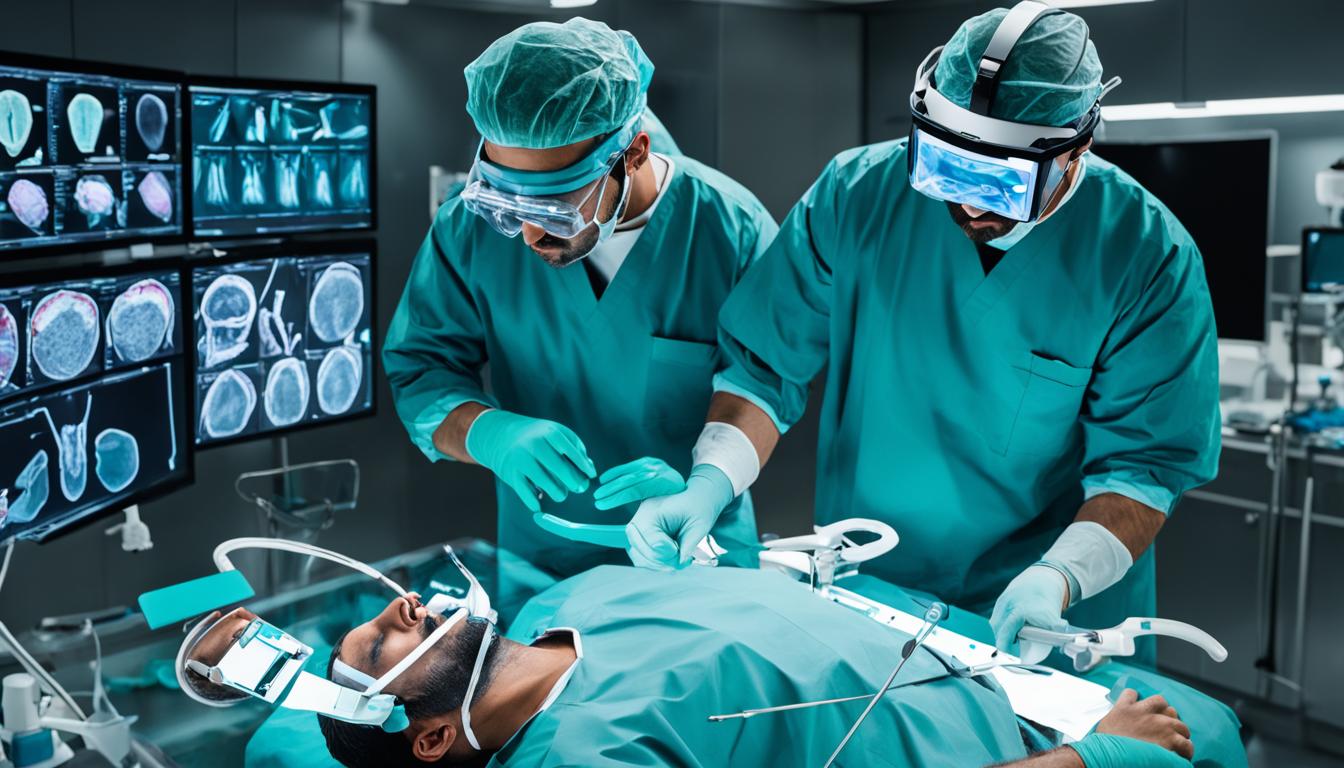Augmented reality (AR) is revolutionizing the field of computer-assisted surgery, offering surgeons enhanced visualization and precision during procedures. By overlaying computer-generated images or data onto the surgeon’s view of the operative field, AR technology provides guidance and support for various disorders in urological interventions.
AR navigation procedures use different imaging modalities like computed tomography, MRI, ultrasound, and single-photon emission computed tomography to create detailed surgical roadmaps. These roadmaps are then registered with the real-life surgical view using various approaches, enhancing the surgeon’s understanding of anatomical structures and critical navigation points.
This technology also introduces noninvasive modalities such as drop-in ultrasound, transurethral ultrasound, gamma probes, and fluorescence cameras, reducing X-ray exposure and addressing soft-tissue deformations.
Contents
- 1 Applications of Augmented Reality in Computer-Assisted Surgery
- 2 Role of Augmented Reality in Minimally Invasive Surgery
- 3 Augmented Reality Visualization in Computer-Assisted Surgery
- 4 Advances in Augmented Reality for Surgical Navigation
- 5 Augmented Reality in Surgical Training
- 6 Benefits of Augmented Reality in Computer-Assisted Surgery
- 7 Conclusion
- 8 FAQ
- 8.1 How is augmented reality used in computer-assisted surgery?
- 8.2 What are the benefits of augmented reality in computer-assisted surgery?
- 8.3 What are the applications of augmented reality in computer-assisted surgery?
- 8.4 How does augmented reality contribute to minimally invasive surgery?
- 8.5 What is the role of augmented reality in surgical navigation?
- 8.6 How is augmented reality used in surgical training?
- 8.7 What are the benefits of augmented reality in computer-assisted surgery?
- 9 Source Links
Key Takeaways:
- Augmented reality (AR) overlays computer-generated images onto the surgeon’s view to enhance visualization and precision in surgery.
- Different imaging modalities are used to create detailed surgical roadmaps for optimal navigation.
- Noninvasive modalities reduce patients’ exposure to X-ray doses and address soft-tissue deformations.
- AR technology has the potential to revolutionize surgical practices and improve patient outcomes in the long run.
Applications of Augmented Reality in Computer-Assisted Surgery
Augmented reality (AR) technology has revolutionized computer-assisted surgery by offering various applications that enhance surgical procedures. In this section, we will explore the different ways in which augmented reality is used in surgical settings, including training, preoperative planning, and intraoperative guidance.
One of the key applications of augmented reality is in surgical training. Surgeons can utilize AR software to create realistic surgical simulations that allow trainees to practice complex procedures before operating on real patients. This technology provides a safe and controlled environment for trainees to develop their skills, leading to improved proficiency and patient outcomes.
Additionally, augmented reality technology, such as optical head-mounted displays like Google Glass or Vuzix STAR, plays a vital role in preoperative planning. Surgeons can overlay computer-generated images onto their real-time view of the operative field, providing a composite view of the patient’s anatomy. This enhanced visualization enables surgeons to better understand anatomical structures and plan their surgical approach more effectively.
Intraoperative guidance is another significant application of augmented reality in surgery. Surgeons can use AR technology to overlay computer-generated images onto their view of the operative field, providing real-time guidance during the procedure. This allows for improved accuracy and precision, reducing the risk of complications and enhancing patient outcomes.
Augmented reality software for surgical procedures has proven to be a game-changer in the field of computer-assisted surgery. It offers a wide range of applications, including training, preoperative planning, and intraoperative guidance, that improve surgical accuracy, reduce complications, and enhance patient outcomes.
Benefits of Augmented Reality in Surgery:
- Improved surgical accuracy
- Enhanced visualization of anatomical structures
- Reduced risk of complications
- Enhanced preoperative planning
- Real-time intraoperative guidance
- Improved surgical training and proficiency
- Enhanced patient outcomes
Augmented reality technology has transformed the way surgeons approach computer-assisted surgery. By providing enhanced visualization, real-time guidance, and improved training opportunities, AR has the potential to revolutionize the field and improve surgical practices worldwide.
Role of Augmented Reality in Minimally Invasive Surgery
Augmented reality (AR) technology has revolutionized the field of minimally invasive surgery, playing a crucial role in enhancing surgical navigation and improving patient outcomes. By providing real-time guidance and visualization, AR empowers surgeons to perform complex maneuvers with precision, minimizing the risk of errors and ensuring the avoidance of critical structures.
The role of augmented reality in minimally invasive surgery extends to various medical specialties, including cardiac valve repair and brain tumor removal. Recent advances in AR technology have further improved the speed and safety of these procedures, opening up new possibilities and advancements in surgical navigation.
One notable example of the role of AR in minimally invasive surgery is cardiac valve repair. With augmented reality, surgeons can visualize and navigate through intricate anatomical structures in real-time, ensuring optimal precision and reducing the likelihood of complications during the procedure.
Similarly, in the field of brain tumor removal, augmented reality allows surgeons to accurately locate and target tumors with enhanced visualization, leading to more successful surgical outcomes. This technology provides surgeons with a comprehensive view of the patient’s brain, overlaying virtual tumor models onto the surgical field, and guiding the surgical instruments with precision.
Furthermore, the role of augmented reality in minimally invasive surgery extends beyond navigation and visualization. It also offers the potential for remote collaboration, allowing experts in different locations to provide real-time guidance and support during complex procedures. This collaborative approach enhances patient care by leveraging the expertise and experience of medical professionals from around the world.
The advancements in augmented reality for surgical navigation have transformed the field of minimally invasive surgery, offering improved precision, safety, and patient outcomes. With ongoing research and development efforts, augmented reality continues to pave the way for future innovations, shaping the future of surgical practice.
The Potential of Augmented Reality in Minimally Invasive Procedures
As augmented reality technology continues to evolve, its potential in minimally invasive surgery becomes increasingly promising. Here are some of the key advantages and advances:
1. Improved Visualization: Augmented reality provides surgeons with a comprehensive view of the patient’s anatomy, overlaying virtual models onto the real-time surgical field. This enhanced visualization allows for precise navigation and accurate targeting of specific structures.
2. Real-time Guidance: AR technology offers real-time guidance, ensuring that surgeons can perform complex procedures with confidence. The augmented reality system can display crucial information, such as the location of critical vessels or nerves, directly in the surgeon’s view, reducing the risk of complications.
3. Enhanced Safety: By providing surgeons with clear visual cues and guidance, augmented reality minimizes the risk of errors and complications during minimally invasive procedures. Surgeons can navigate through complex anatomical structures with utmost precision, ensuring patient safety.
4. Remote Collaboration: Augmented reality enables remote collaboration, allowing surgeons to seek advice and guidance from experts in real-time, regardless of their location. This collaborative approach enhances the quality of patient care and opens up opportunities for knowledge sharing and advanced training.
These advances in augmented reality for surgical navigation highlight the transformative potential of this technology in minimally invasive surgery. As researchers and innovators continue to push the boundaries of augmented reality, the field can expect further improvements in procedural accuracy, patient safety, and surgical outcomes.
| Advantages | Advances |
|---|---|
| Improved visualization | Patient-specific virtual models for precise navigation |
| Real-time guidance | Integration of augmented reality with robotics and AI |
| Enhanced safety | Automatic registration tools for streamlined procedures |
| Remote collaboration | Use of 3D printing techniques for patient-specific surgical guides |
Augmented Reality Visualization in Computer-Assisted Surgery
Augmented reality (AR) visualization plays a crucial role in computer-assisted surgery, providing surgeons with real-time overlays of computer-generated images or data onto their view of the operative field. This innovative technology enhances spatial awareness, improves anatomical understanding, and facilitates precise instrument guidance during surgical procedures.
By utilizing augmented reality visualization, surgeons can benefit from a comprehensive and detailed view of the patient’s anatomy. This augmented view allows for better visualization of complex structures, such as blood vessels or tumors, enabling surgeons to navigate through delicate areas with increased precision and accuracy.
“Augmented reality visualization in computer-assisted surgery provides surgeons with enhanced spatial awareness, improved anatomical understanding, and precise instrument guidance.”
AR visualization is particularly valuable in minimally invasive surgeries, where the surgeon’s view is limited by small incisions. By overlaying computer-generated images onto the live surgical view, augmented reality bridges the gap between imaging and reality, providing surgeons with a more comprehensive understanding of the surgical site.
Furthermore, augmented reality visualization has a significant impact on surgical training. Trainees can benefit from realistic simulations of surgical procedures, allowing them to gain proficiency and confidence in their skills before operating on actual patients. These simulations offer trainees a controlled environment where they can practice complex procedures, receive real-time feedback, and refine their techniques.
In addition, augmented reality visualization opens up new avenues for surgical education. Surgeons can use this technology to enhance teaching methods by demonstrating complex procedures and highlighting critical anatomical structures. By providing an immersive and interactive learning experience, augmented reality plays a vital role in advancing surgical education.
Applications of Augmented Reality in Surgical Training
| Application | Benefits |
|---|---|
| Realistic surgical simulations | Allows trainees to practice procedures and develop skills in a controlled environment |
| Real-time feedback and guidance | Enhances learning process and improves trainees’ proficiency |
| Improved surgical education | Provides immersive and interactive learning experiences |
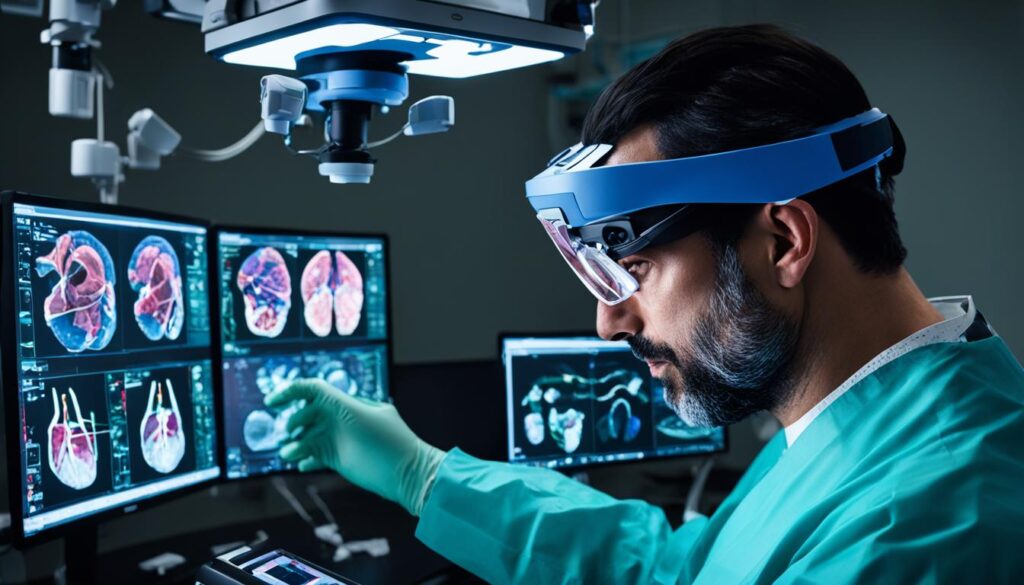
In conclusion, augmented reality visualization is revolutionizing computer-assisted surgery by enhancing surgeons’ spatial awareness, anatomical understanding, and instrument guidance. With applications in surgical training and education, augmented reality is paving the way for improved surgical outcomes and the advancement of surgical practices.
Advances in augmented reality (AR) technology are revolutionizing surgical navigation in computer-assisted surgery. Ongoing research and development efforts have led to significant improvements in the accuracy and efficiency of AR systems used in surgical procedures. These advancements are reshaping the future of computer-assisted surgery, offering surgeons enhanced capabilities and improved patient outcomes.
One of the notable advances in augmented reality for surgical navigation is the use of patient-specific tools with visual patterns for automatic registration. This technique allows for precise alignment of preoperative imaging data with the real-time surgical view, enhancing the accuracy of surgical navigation. By customizing the tools to each patient’s unique anatomy, surgeons can achieve enhanced precision and minimize potential errors.
Another breakthrough in surgical navigation is the integration of augmented reality with other technologies, such as artificial intelligence (AI) and robotics. This integration enables real-time analysis of surgical data, providing surgeons with valuable insights and decision support during procedures. The combination of AR, AI, and robotics has the potential to streamline surgical workflows, improve efficiency, and enhance patient safety.
Furthermore, three-dimensional (3D) printing techniques have been employed to create patient-specific surgical guides. These guides assist surgeons in navigating complex anatomical structures and ensure optimal surgical outcomes. The precise alignment of the guides with the patient’s anatomy, facilitated by augmented reality, allows for greater precision and accuracy during surgery.
| Advances | Benefits |
|---|---|
| Use of patient-specific tools with visual patterns | Enhanced alignment and accuracy in surgical navigation |
| Integration with AI and robotics | Real-time analysis and decision support during procedures |
| Three-dimensional (3D) printing for surgical guides | Improved precision and navigation in complex surgeries |
These advances in augmented reality for surgical navigation hold great promise for the future of computer-assisted surgery. Surgeons are increasingly able to leverage AR technology to overcome the challenges posed by complex anatomical structures, ultimately improving patient outcomes. As further research and development continue, we can anticipate even more groundbreaking innovations that will shape the field of surgery and pave the way for safer, more efficient procedures.
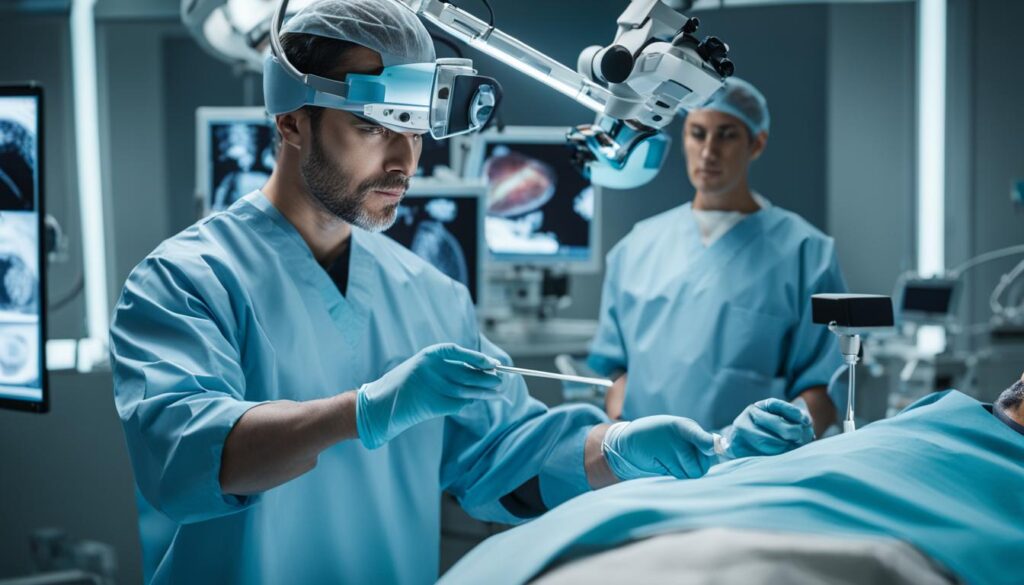
Augmented Reality in Surgical Training
Augmented reality (AR) is revolutionizing surgical training by providing realistic, interactive simulations for trainees. With the use of AR technology, trainees can immerse themselves in a virtual environment that recreates complex surgical scenarios. This enables them to practice procedures and develop their skills in a safe and controlled space before operating on real patients.
One of the key advantages of augmented reality in surgical training is its ability to offer trainees real-time feedback and guidance during training sessions. As trainees perform simulated surgeries, AR systems can provide instant feedback on their technique, precision, and decision-making. This enhances the learning process and helps trainees develop the necessary proficiency to perform surgical procedures successfully.
The use of AR in surgical training also allows for the creation of detailed and interactive educational content. Trainees can access virtual surgical libraries that contain a wealth of knowledge, including anatomical models, step-by-step guides, and case studies. This enables them to learn at their own pace and revisit specific concepts as needed.
AR technology offers a unique opportunity for surgical trainees to learn in a highly immersive and interactive manner. By providing realistic simulations, real-time feedback, and access to a wealth of educational resources, augmented reality enhances the quality of surgical education and sets a new standard for training future surgeons.
Moreover, augmented reality can facilitate collaboration and knowledge sharing among trainees and experienced surgeons. In a simulated environment, trainees can work together on complex surgical cases, exchanging insights, and learning from each other’s experiences. This promotes a sense of teamwork and fosters a culture of continuous improvement in surgical training.
With the rapid advancements in AR technology, the potential applications for surgical training are expanding. From basic surgical skills to complex procedures, augmented reality can provide trainees with a range of training modules tailored to their specific needs.
Benefits of Augmented Reality in Surgical Training:
- Realistic and interactive simulations allow trainees to practice procedures.
- Real-time feedback and guidance enhance the learning process.
- Access to virtual surgical libraries enhances knowledge acquisition.
- Facilitates collaboration and knowledge sharing among trainees and experienced surgeons.
- Offers training modules tailored to trainees’ specific needs.
With the growing adoption of augmented reality in surgical training, the future of surgical education looks promising. Trainees can expect more immersive and interactive learning experiences, leading to improved surgical skills and patient safety.
Applications of Augmented Reality in Surgical Training
The table below highlights some of the key applications of augmented reality in surgical training:
| Application | Description |
|---|---|
| Surgical Simulations | Realistic simulations of surgical procedures for trainees to practice and refine their skills. |
| Anatomical Visualization | Overlaying virtual anatomical models onto the trainee’s view for enhanced visualization and understanding. |
| Procedure Guidance | Real-time guidance and feedback during simulated surgeries to improve technique and precision. |
| Collaborative Training | Virtual environments that facilitate teamwork and knowledge sharing among trainees and experienced surgeons. |
| Educational Resources | Access to virtual surgical libraries containing educational content such as case studies and step-by-step guides. |
In conclusion, augmented reality is revolutionizing surgical training by providing realistic simulations, real-time feedback, and access to a wealth of educational resources. The use of AR technology in surgical training enhances the quality of education, improves surgical skills, and promotes patient safety.
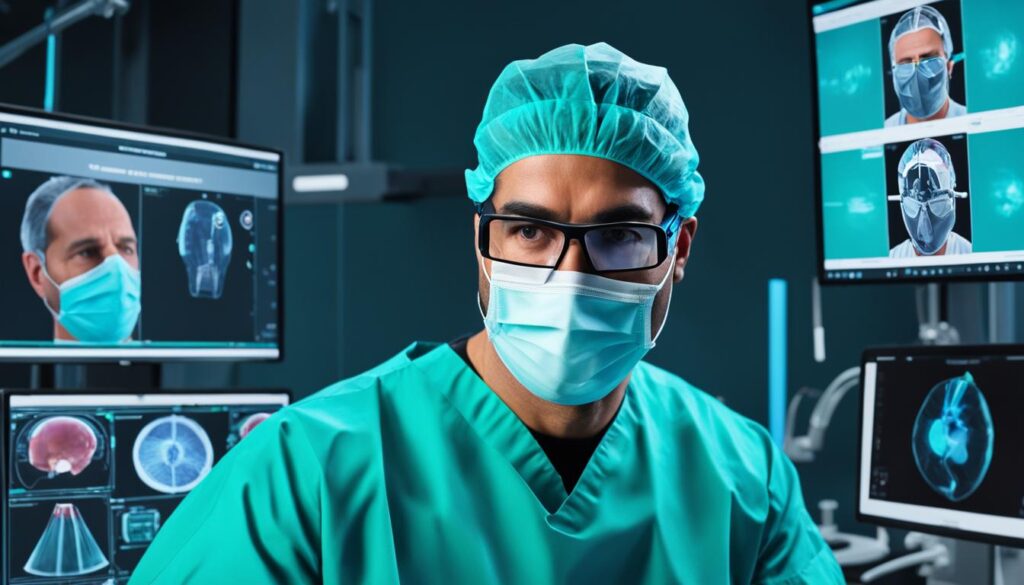
Benefits of Augmented Reality in Computer-Assisted Surgery
Augmented reality (AR) technology has brought numerous benefits to the field of computer-assisted surgery, revolutionizing the way surgeons perform procedures and improving patient outcomes. By providing enhanced visualization and guidance, AR technology enhances surgical precision and accuracy, leading to a range of advantages for both surgeons and patients.
Improved Surgical Precision and Accuracy
One of the key benefits of augmented reality in computer-assisted surgery is its ability to improve surgical precision and accuracy. By overlaying computer-generated images onto a surgeon’s view of the operative field, AR technology enhances the visualization of anatomical structures and provides real-time guidance. Surgeons can effectively navigate complex procedures with greater confidence, ensuring critical structures are avoided and reducing the risk of complications.
Reduced Complications and Shorter Operating Times
With the assistance of augmented reality, surgeons can achieve more accurate and precise surgical outcomes, leading to a reduction in complications. By utilizing AR technology, surgeons can plan and execute procedures with a higher level of accuracy, minimizing errors and improving overall surgical efficacy. Additionally, the enhanced visualization provided by AR can streamline surgical workflows, potentially leading to shorter operating times.
Real-Time Feedback and Interaction
Another distinct advantage of augmented reality in computer-assisted surgery is the ability to provide real-time feedback and interaction between surgeons and trainees. Through AR technology, trainees can receive guidance and instruction from experienced surgeons during surgical procedures. This facilitates the transfer of surgical skills and knowledge, allowing trainees to develop their proficiency in a supportive and controlled environment.
Enhanced Patient Safety and Surgical Planning
The integration of augmented reality into computer-assisted surgery enhances patient safety by reducing errors and improving surgical planning. AR technology allows surgeons to visualize critical structures and plan procedures with greater precision. Surgeons can assess potential risks and determine the optimal approach, leading to improved surgical decision-making and better patient outcomes.
Advancements in Surgical Education
The use of augmented reality in computer-assisted surgery has also advanced the field of surgical education. By providing realistic and interactive simulations, AR technology offers trainees a valuable learning tool. Trainees can practice surgical procedures in a controlled environment, gaining experience and developing their surgical skills. Augmented reality enhances the quality of surgical education, ultimately leading to better-trained surgeons and improved patient safety.
Overall, the benefits of augmented reality in computer-assisted surgery are far-reaching. From improved surgical precision and reduced complications to enhanced patient safety and surgical education, AR technology has the potential to transform the field of surgery. As advancements continue, the integration of augmented reality is expected to play a significant role in shaping the future of computer-assisted surgery.
| Benefits of Augmented Reality in Computer-Assisted Surgery |
|---|
| Improved surgical precision and accuracy |
| Reduced complications and shorter operating times |
| Real-time feedback and interaction |
| Enhanced patient safety and surgical planning |
| Advancements in surgical education |
Note: The table above summarizes the key benefits of augmented reality in computer-assisted surgery.
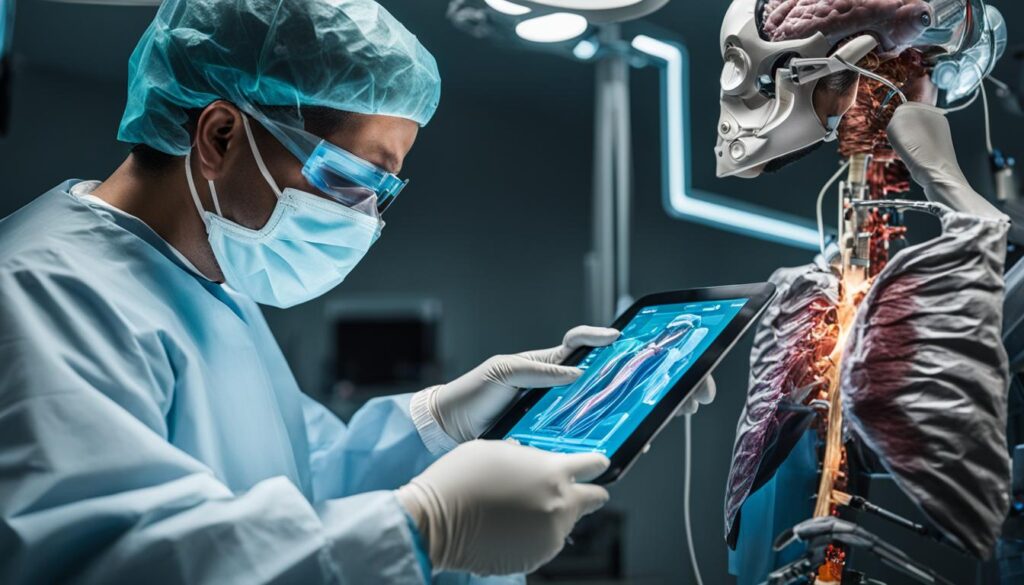
Conclusion
In conclusion, the use of augmented reality (AR) in computer-assisted surgery is revolutionizing the field, providing surgeons with enhanced visualization, guidance, and training opportunities. AR technology has shown promising results in terms of improved accuracy, reduced complications, and enhanced patient outcomes. Surgeons can benefit from the composite view of the patient’s anatomy, overlaying computer-generated images onto their real-time view of the operative field.
Ongoing advancements in augmented reality for surgical navigation and visualization are pushing the boundaries of what is possible in computer-assisted surgery. Researchers are exploring new techniques, such as patient-specific tools with visual patterns, 3D printing for patient-specific surgical guides, and the integration of augmented reality with other technologies like artificial intelligence and robotics. These advancements hold great promise for the future of computer-assisted surgery, offering improved capabilities and outcomes for surgeons.
As augmented reality technology continues to evolve, it has the potential to transform the field of computer-assisted surgery and improve surgical practices worldwide. The benefits of augmented reality, including enhanced visualization, real-time feedback, and interaction, can lead to reduced errors, improved surgical planning, shorter operating times, and ultimately, better patient care. Augmented reality is paving the way for a new era in surgical procedures, where precision, accuracy, and patient outcomes are at the forefront.
FAQ
How is augmented reality used in computer-assisted surgery?
Augmented reality in computer-assisted surgery involves overlaying computer-generated images or data onto a surgeon’s view of the operative field, enhancing visualization and precision during surgical procedures.
What are the benefits of augmented reality in computer-assisted surgery?
Augmented reality technology improves surgical precision and accuracy, resulting in reduced complications, shorter operating times, and improved patient outcomes.
What are the applications of augmented reality in computer-assisted surgery?
Augmented reality can be used for training, preoperative planning, and intraoperative guidance in surgical procedures, enhancing visualization and improving surgical practices.
How does augmented reality contribute to minimally invasive surgery?
Augmented reality provides real-time guidance and navigation for surgeons during minimally invasive procedures, enhancing accuracy and precision while avoiding critical structures.
Advances in augmented reality technology have improved surgical navigation, offering surgeons enhanced capabilities and outcomes in areas such as cardiac valve repair and brain tumor removal.
How is augmented reality used in surgical training?
Augmented reality offers realistic, interactive simulations for surgical trainees, allowing them to practice procedures in a virtual environment and receive real-time feedback and guidance.
What are the benefits of augmented reality in computer-assisted surgery?
Augmented reality improves surgical precision and accuracy, enhances patient outcomes, facilitates surgical training, and enhances patient safety by reducing errors and improving surgical planning and decision-making.

